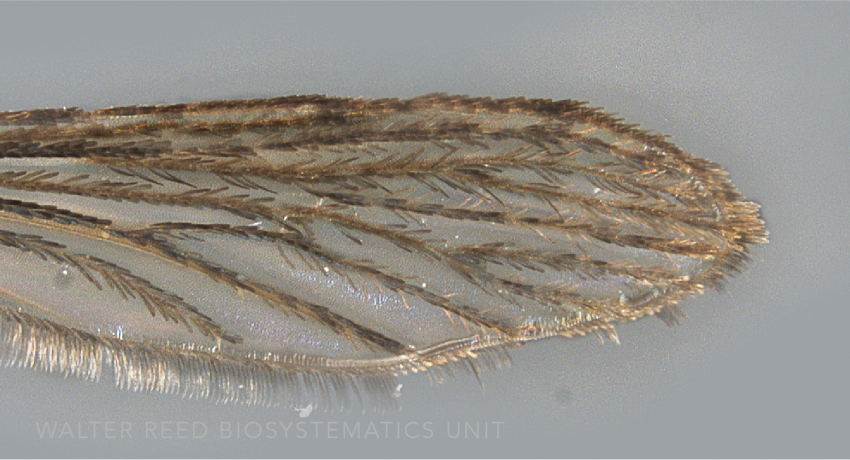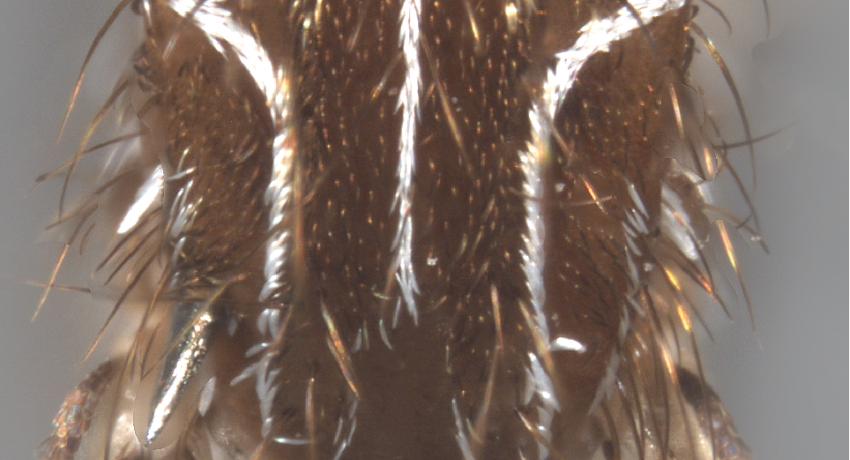AUSTRALASIAN & ORIENTAL REGIONS
[United States invasive]
Etymology: back (Gr), to write (L); refers to thorax “with several fine longitudinal lines”
Aedes notoscriptus is an attractively “spotty” mosquito, with clusters of bright-white scales on the ends of the palps and across the lateral thorax. Aedes notoscriptus is one of three species in the subgenus Rampamyia, which includes the Australasian taxa Ae. albilabris Edwards and Ae. quinquelineatus Edwards. It has one recognized subspecies—Aedes notoscriptus montanus Brug, originally described from Lembang, Java. Several studies have provided evidence for cryptic taxa but there have been no efforts to formally describe the species. Distinct genetic lineages have been noted in populations of Ae. notoscriptus in Australia and New Zealand, which correlate with wing centroid size. Allozyme data indicated at least five distinct genetic signatures in over 17 populations sampled—four in New South Wales and another in Darwin. Whole mitochondrial genomes revealed two distinct species, and geographical differences in egg morphology have also been reported, however there have been no efforts to formally describe the component taxa.
Type locality: Sydney, New South Wales, Australia
Type depository: Macleay Museum of Natural History, University of Sydney, Sydney, Australia (MM)
DIAGNOSTIC CHARACTERS (Click photos to view; mouse over and click large photo to zoom in.)
ADULT (illustrated): Head: Proboscis (P) dark-scaled with median pale ring. Thorax: Scutum (Scu) with lyre-shaped lateral silvery lines, narrow median silvery lines and anterior sublateral golden lines of scales; postpronotum with small distinct lower patch of silvery scales; antealar area with distinct silvery scale patch. Wing: Scales all dark dorsally. Legs: Fe-II and Ti-III with anterior lines of pale scales along nearly whole length.
LARVA (not illustrated): Head: Seta 1-C robust, sharply hooked; seta 5-C single. Abdominal segments: Without conspicuous stellate setae. Terminal segments: Comb scales in irregular triangular patch; siphon not pilose; siphonal acus large and broadly joined to siphon; seta 1-S short, <0.5 x length of siphon.
TAXONOMIC KEYS
Lee et al. 1982
Becker et al. 2010
Exemplar DNA sequences
Ae. notoscriptus COI: KU495076–80, MG242508
BIONOMICS
Immatures
Immatures of the invasive, container-breeding Ae. notoscriptus s.l. can develop in a wide variety of natural containers—leaf axils, rock pools, tree holes, bamboo stumps, coconut husks and shells, palm fronds—and a variety of large and small artificial containers made of cement, wood and metal. Aedes notoscriptus s.l. has recently adapted to peri-domestic environs, where it is extremely common in roof gutters.
Adults
In New Zealand, Ae. notoscriptus s.l. is a ferocious biter and frequently enters houses to feed, but biting behaviors are known to vary. In native forests of New Zealand, Ae. notoscriptus was detected at both ground level and 10m up in the canopy. In Australia, the species is a common urban pest, biting people in shaded areas throughout the day. Its other proven hosts include dogs, brushtail possums, birds, cats, and flying foxes. Viral transmission competency varies geographically.
DISTRIBUTION NOTES
Australia, Indonesia, New Caledonia, Papua New Guinea, New Zealand, Philippines, Solomon Islands, United States (continental).

WRBU VECTOR HAZARD REPORTS
None; View other WRBU Vector Hazard Reports
Available GIS Models
None
IMPORTANT REFERENCES (full citations below)
Skuse 1889: 1738 (M*, F; as Culex)
Bancroft 1908: 24 (M, F; as genus Scutomyia)
Brug 1934a: 513 (M*)
Lee 1944a: 57 (L*)
Penn 1949b: 43 (P*)
Bick 1951: 408 (bionomics)
Belkin 1962: 348 (M*, F, P*, L*)
Dobrotworsky 1965: 131 (M*, F*, L*)
Mohrig 1967 (F*)
Belkin 1968a: 103 (distribution)
Maffi 1973b: 46 (distribution)
Lee et al. 1982: 196 (F key, taxonomy, bionomics, distribution, review)
Linley et al. 1991b (E*)
Derraik 2004 (distribution; New Zealand)
Foley et al. 2004 (bionomics, molecular genetics)
Reinert 2008f: Fig. 1 (F*)
Becker et al. 2010: 358 (F*, L*; key, taxonomy, distribution, bionomics)
Endersby et al. 2013 (sensu lato; molecular taxonomy)
Peterson & Campbell 2015 (US invasive, niche model)
CURRENT SYNONYMS
ssp. montanus Brug
1939: 104 (M*; as Aedes). Type locality: Lembang, Java (NHMUK). Distribution: Indonesia. References: Stone et al. 1959: 167 (n.). Etymology: from a mountain (L). Informal name: Montane Indonesian Pointy Mosquito.
CURRENT SUBSPECIES
None
CITED REFERENCES
Bancroft, T. L. (1908). List of the mosquitoes of Queensland, with the original descriptions and notes on the life-history of a number. Annals of the Queensland Museum, 8, 1–64.
Becker, N., Petrić, D., Zgomba, M., Boase, C., Madon, M., Dahl, C., & Kaiser, A. (2010). Mosquitoes and their control (Second ed.). Berlin Heidelberg: Springer-Verlag.
Belkin, J.N. (1962). The mosquitoes of the South Pacific (Diptera, Culicidae) (Vols. 1 & 2). Berkeley, California: University of California Press.
Belkin, J.N. (1968a). Mosquito studies (Diptera, Culicidae) VII. The Culicidae of New Zealand. Contributions of the American Entomological Institute, 3(1), 1–182.
Bick, G. H. (1951). The ecology of the mosquito larvae of New Guinea. Pacific Science, 5(4), 392–431.
Brug, S.L. (1934a). Notes on Dutch East Indian mosquitos. Bulletin of Entomological Research, 25, 501–519.
Derraik, J.G.B. (2004). Exotic mosquitoes in New Zealand: A review of species intercepted, their pathways and ports of entry. Australian and New Zealand Journal of Public Health, 28(5), 433–444.
Dobrotworsky, N.V. (1965). The mosquitoes of Victoria (Diptera, Culicidae). London and New York.
Endersby, N.M., White, V.L., Chan, J., Hurst, T., Rašić, G., Miller, A., & Hoffman, A.A. (2013). Evidence of cryptic genetic lineages within Aedes notoscriptus (Skuse). Infection, Genetics and Evolution, 18, 191–201.
Foley, D.H., Russell, R.C., & Bryan, J.H. (2004). Population structure of the peridomestic mosquito Ochlerotatus notoscriptus in Australia. Medical and Veterinary Entomology, 18(2), 180–190.
Lee, D.J. (1944a). An atlas of the mosquito larvae of the Australasian Region. Tribes- Megarhinini and Culicini. Australian Military Forces, Headquarters.
Lee, D.J., Hicks, M.M., Griffiths, M., Russell, R.C., & Marks, E.N. (1982). The Culicidae of the Australasian region. Volume 2. Commonwealth Department of Health, School of Public Health and Tropical Medicine Monograph Series, 2.
Linley, J.R., Geary, M.J., & Russell, R.C. (1991b). The eggs of Aedes funereus, Aedes notoscriptus and Aedes alternans (Diptera: Culicidae). Proceedings of the Entomological Society of Washington, 93, 592–612.
Maffi, M. (1973b). The mosquitoes (Diptera, Culicidae) of Rennell and Bellona. The Natural History of Rennell Island, British Solomon Islands, 7, 41–60.
Mohrig, W. (1967). Die taxonomische Bedeutung der Struktur weiblicher Genitalien im Culiciden- Tribus Aedini. Angewandte Parasitologie, 8, 67–100.
Penn, G.H. (1949b). The pupae of the mosquitoes of New Guinea. Pacific Science, 3, 3–85.
Peterson, A.T., & Campbell, L.P. (2015). Global potential distribution of the mosquito Aedes notoscriptus, a new alien species in the United States. Journal of Vector Ecology, 40(1), 191–194.
Reinert, J.F. (2008f). Comparative anatomy of the female genitalia of generic-level taxa in tribe Aedini (Diptera: Culicidae). Part XX. Genus Rampamyia Reinert, Harbach and Kitching. Contributions of the American Entomological Institute, 35(3), 11–18.
Skuse, F.A.A. (1889). Diptera of Australia. Part V.- The Culicidae. Proceedings of the Linnean Society of New South Wales, 3, 1717–1764.
Stone, A., Knight, K.L., & Starcke, H. (1959). A synoptic catalog of the mosquitoes of the World (Diptera, Culicidae) (Vol. 6). Washington, D.C.: Entomological Society of America, The Thomas Say Foundation.
CITE THIS PAGE
Walter Reed Biosystematics Unit (Year). Aedes notoscriptus species page. Walter Reed Biosystematics Unit Website, http://wrbu.si.edu/vectorspecies/mosquitoes/notoscriptus, accessed on [date (e.g. 03 February 2020) when you last viewed the site].











































































































































































